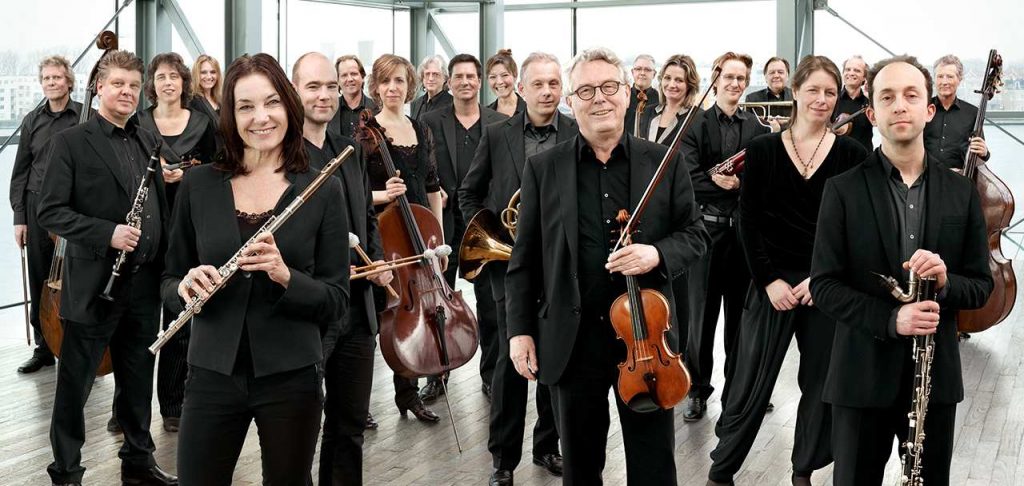Asko|Schönberg stuns Library of Congress with intensity and precision

The Library of Congress has long used its exemplary free concert series to champion new music. The presenter’s latest bold move is to host Asko|Schönberg, the elite ensemble from the Netherlands, for a two-night mini-festival featuring monuments of the 20th and 21st centuries. The first installment on Friday night combined the music of two giant Györgys, Ligeti and Kurtág, with works by lesser-known composers.
Asko|Schönberg is the result of a merger between two Dutch contemporary music ensembles, who performed their first concert as a single entity in 2009. That same year Martijn Padding composed White Eagle for the new group. It is essentially a violin concerto, with fast outer movements, appropriately named “Quirk I” and “Quirk II,” bookending the slow central movement.
“Quirk” certainly describes Padding’s interest in creating unexpected sonic combinations, but also the perky rhythmic character that animates the fast movements. “Quirk I” opened with a simple pulse in the left-hand pizzicato of solo violinist Joseph Puglia. Conductor Olivier Cuendet faultlessly guided the musicians through the constantly shifting metrical changes, marked by siren wails played by combinations of flute or violin with accordion.
The second movement, a musical description of the eponymous raptor seen by Padding in India, centered on longing, descending notes in accordion, clarinet, and strings. Strange sounds coalesced around that foundation, including whale-like cries from the euphonium, avian screeches from bowed flexatone, and the oddly animal calls of small thunder sheets or wobble boards, first from the percussionist and eventually from the other musicians.
Folk music tints marked “Quirk II,” led by Puglia’s balalaika-like strumming of his violin with a pick. The strings responded with pizzicato motifs, followed by the woodwinds in staccato lines. The euphonium got in on the action as the “oom” in an “oom-pah-pah” section, one of many examples of the enigmatic humor and variety in this raucous piece.
Ligeti’s Kammerkonzert, featuring a chamber orchestra of thirteen players, provided a more serious counterweight. The first movement’s murmuring runs in woodwinds and brass, in densely layered counterpoint Ligeti called micropolyphony, showcased the virtuosity of Asko|Schönberg’s fine musicians. Static clusters in the second movement became gradually more animated, assaulted by a hysterical outburst of high strings and woodwinds.
A game of accented attacks played through the third movement, calming and growing more aggressive over time. Hammered strikes, including percussive snap pizzicati beginning in the double-bass and clusters banged on the harpsichord and piano, evoked the dispassionate whir of a machine. The finale tested the entire ensemble’s endurance with breathless cascades of notes that blurred together dizzily.
Canadian composer Claude Vivier’s cantata Bouchara befuddled on many accounts. Soprano Katrien Baerts sang the invented, nonsensical text with impressive self-assurance, although even amplification was not enough to put her on an even footing with the powerful instrumental sounds that attempted to overpower her and often succeeded. Perhaps it was the slowly descending clusters that ran through the piece, with maddening intensity, that gave the feel of a lament, growing in anguished agitation toward the end.
One of the hallmarks of Kurtág’s style has always been meticulous craftsmanship and intimacy, endearingly on display when the Hungarian composer and his late wife performed at the Library of Congress a decade ago. Even in …concertante…, composed for large orchestral forces in 2003, Kurtág features the two solo parts in chamber-sized combinations. The piece won the composer the Grawemeyer Award for Music Composition from the University of Louisville.
This was the world premiere of a new chamber orchestra arrangement of the piece, made by Asko|Schönberg’s conductor Olivier Cuendet at the composer’s request. Violinist Hiromi Kikuchi and her husband, violist Ken Hakii, who premiered the work and have sole performance rights to it, came along for the ride. The solo parts are restrained in sound, with the musicians putting large mutes on their strings and even later switching their instruments for “silent” ones, electronic instruments used primarily for quiet rehearsal.
The piece is most effective in its opening section and coda, featuring sonic smears passed around the instruments. The middle section grew louder, more a jumbled mess of greater rhythmic activity and loud strikes. Shivers of sound, including those made by mallets striking the strings of the harp and the piano, made the work’s conclusion a highlight.
Asko|Schönberg will play selections from Mauricio Kagel’s Die Stücke der Windrose 8 p.m. Saturday. loc.gov


